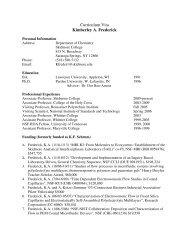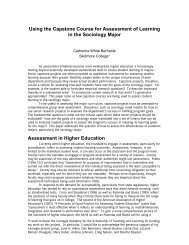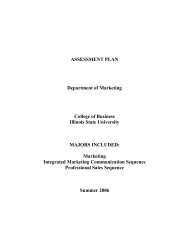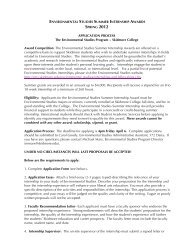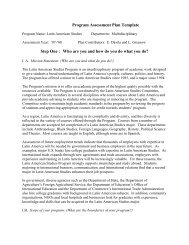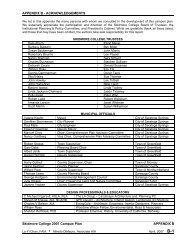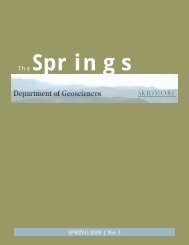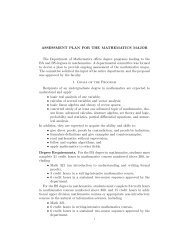Example 1 - Skidmore College
Example 1 - Skidmore College
Example 1 - Skidmore College
You also want an ePaper? Increase the reach of your titles
YUMPU automatically turns print PDFs into web optimized ePapers that Google loves.
DETERMINATION OF LONG-TERM SEDIMENT GENERATION<br />
RATES OF LARGE STEEP-SLOPED CANYONS WITH<br />
HETEROGENEOUS STRATIGRAPHY USING IN SITU 10 BE,<br />
GRAND CANYON, ARIZONA
Abstract<br />
Study of the Colorado River in Grand Canyon, Arizona, has very direct<br />
applications to the relationship between sedimentation and regulation of the river system.<br />
Studies of sediment yield in this river stretch are well documented, however, the rates of<br />
sediment introduction into the system are not well known. This study provides a longterm<br />
average sediment yield of the Colorado River and its tributaries as a function of<br />
distance in the Grand Canyon using cosmogenic 10 Be. By gaining a four dimensional<br />
understanding, in space and time, of the movement of sediment within the Grand Canyon<br />
we will better understand the dynamic sediment system. The advantage of long-term<br />
averages presents the ability to compare and improve short-term sediment flux averages<br />
that may be skewed by short-term climatic or sediment yield cycles.<br />
Introduction<br />
Exposing two billion years of geologic history and serving as the life-blood of the<br />
Southwest, the degree of richness and dynamics of the Colorado River in the Grand<br />
Canyon is unparallel. The Grand Canyon extends 448 km (278 miles) across the<br />
northwestern part of Arizona (Fig. 1), stretching between Lake Powell on the east end<br />
and Lake Mead on the west. The Grand Canyon was formed when the Colorado River cut<br />
into the southwestern region of the Colorado Plateau (Fig. 2). Over the course of its path<br />
through the Grand Canyon, the Colorado River drops approximately 610 m (Beus and<br />
Morales, 1990).<br />
The water that flows through the Grand Canyon embodies the union of four major<br />
rivers, the Green, San Juan, Little Colorado, and Colorado, as well as many minor<br />
tributaries (Beus and Morales, 1990). Following a major flood in 1905, regulation first<br />
began on the Colorado River. Since that time, regulation has become quite extensive<br />
(Kieffer, 1990).<br />
Monitoring between 1921 and 1962 at Phantom Ranch shows that prior to regulation<br />
of the Colorado River in Grand Canyon, the average discharge was 17,000 cubic feet per<br />
second (cfs). The mean annual flood was 77,500 cfs, with many larger floods; an 1884<br />
flood measured 300,000 cfs. At the same location, the sediment load was measured at<br />
over 275 Mg per day. Upon the closure and the filling of Glen Canyon Dam reservoir in<br />
1963, the average discharge dropped to 11,000 cfs and sediment load to only about 45<br />
1
Mg per day. The Colorado River, Spanish for “colored red” due its amount of sediment,<br />
began to often run clear following regulation (Kieffer, 1990).<br />
Due to the inherent importance of sediment transport to the river, the Colorado River<br />
sediment yield has been an important topic of research. There exist short-term estimates<br />
of sediment yield and transportation rates of the Colorado River in Grand Canyon (such<br />
as Graf et al., 1991; Howard and Dolan, 1981; Webb et al., 2000), however, this study<br />
will provide a long-term sediment production rate by measuring the average erosion rate<br />
within the Colorado River basin in the Grand Canyon region. A long-term average will<br />
effectively cancel out periodic cycles or fluctuations that could skew a short-term<br />
average, providing a clear standardized understanding of the systems sediment yield.<br />
Justification<br />
This study will provide a dynamic and diverse understanding to the Colorado River<br />
basin system in the Grand Canyon, Arizona. Prior studies have investigated<br />
contemporary sediment yield and sediment transportation of the Colorado system in<br />
Grand Canyon (such as Graf et al., 1991; Howard and Dolan, 1981; Webb et al., 2000);<br />
however, no long-term average sediment yield rates are known. The scope of this study is<br />
threefold, it will (1) provide a rate at which sediment is delivered to the system; (2)<br />
enable understanding of the spatial distribution of tributary erosion; and (3) model rates<br />
at which sediment is delivered downstream. The importance of a firm understanding of<br />
sediment yield is understood considering the degree of regulation that exists on the<br />
Colorado River.<br />
The regulation of the Colorado River has been a significant source of study. Since the<br />
dams closure in 1963, there have been many studies investigating the impact of the<br />
regulation on sediment yield, transportation, and deposition within Grand Canyon.<br />
Further, the rate at which sediment is being delivered to Lake Mead is also a source of<br />
concern. Monitoring of the Colorado River through this stretch only dates back to the late<br />
1800’s using photographic comparison, with quantitative measurements much more<br />
recently (Webb, 1996; Melis et al., 1995). Considering the amount of interannual and<br />
interdecadal precipitation variability (Figs. 3 and 4), one begins to appreciate the<br />
importance of a long-term sediment influx rate of the Colorado River if understanding of<br />
the effects of regulation is to be effective. Such long-term understanding is highlighted in<br />
2
the Grand Canyon where cyclic erosion and deposition are present in the Colorado River<br />
below Glen Canyon Dam. Due to this cyclic quality, “data biasing” is a risk depending on<br />
study duration and recurrence period (Cluer, 1995). Consequently, a long-term<br />
understanding would compensate for any possible micro- or macro-cycling of sediment<br />
load.<br />
Literature Review<br />
Rate of erosion using cosmogenic isotopes<br />
The constant exposure of cosmic radiation causes fast moving nuclides to collide into<br />
Earth’s surface forming cosmogenically produced isotopes. Cosmogenic isotope dating is<br />
based upon the accumulation of certain nuclides that form due to this interaction of<br />
cosmic radiation with exposed surface matter. The isotopes are only produced in the top<br />
few meters of crust, allowing for applications to landform ages and geomorphic<br />
evolution. The accumulation of these cosmogenic nuclides is proportional to cosmic ray<br />
intensity and the concentration of target nuclides in material. Consequently, the amount<br />
of cosmogenic isotopes relates to the duration that materials have been exposed to cosmic<br />
radiation (Zreda and Phillips, 2000).<br />
Due to the production method, the dosing of cosmogenic rays is not constant for all<br />
latitudes, elevations, and burial depths. The nuclides producing cosmogenic isotopes are<br />
deflected by Earth’s magnetic field and interact with Earth’s atmosphere. Consequently,<br />
cosmic flux is greatest at high latitudes and high elevations (Bierman, 1994). Production<br />
rates also decrease exponentially with depth (Lal, 1988). For these reason corrections to<br />
cosmogenic production rates must be made accordingly to the specific latitude, elevation,<br />
and burial depth parameters (Fig. 6) (Bierman, 1994).<br />
While cosmogenic isotopes are effective for evaluating point location erosion rates,<br />
analysis of isotope concentration in alluvial sediment enables calculation of basin-wide<br />
erosion rate. Bierman and Steig (1996) provide a model for such analysis. This model<br />
assumes an isotopic steady state for the sediment isotope budget within the study basin<br />
(Fig. 7); the in-going isotope flux (IIN) is equal to the out-going isotope flux (IOUT).<br />
Accordingly, the isotope reservoir (NRES) would remain constant, as well as the flux of<br />
mass within the basin (MOUT). IIN is a function of cosmogenic bombardment, while IOUT is<br />
equal to isotope loss due to decay (ID) and isotope transport out of the basin (ITRAN).<br />
3
Isotopes are transported out of the basin through isotopes in sediment (ISED) and isotopes<br />
in solution (ISOL). Consequently, the relationship established is such that:<br />
IIN = IOUT = ID + ITRAN = ID + ISOL + ISED (1)<br />
MIN = MOUT = constant (2)<br />
(Bierman and Steig).<br />
An inverse relationship exists between the flux of cosmogenic isotopes leaving a<br />
basin and the rate of basin erosion. The longer sediment is exposed to cosmic rays, longer<br />
dosage time, the higher the isotope concentration; consequently the higher the dose, the<br />
slower the erosion rate (Bierman and Steig).<br />
Bierman and Steig present a model for calculating average rate of basin-wide mass<br />
loss (m * ):<br />
m * = [Λ(P J 0 eff - C J SED λ)] / C J SED, (3)<br />
where average rate of basin-wide mass loss (m * ) is a function of attenuation factor (Λ),<br />
effective basin-wide production rate at ground surface (P J 0 eff), average isotope<br />
concentration in sediment leaving basin (C J SED), and decay constant (λ). Depending on<br />
the rate of transport within the basin, the decay constant (λ), may become negligibly low,<br />
changing the equation to:<br />
m * = [Λ P J 0 eff ] / C J SED. (4)<br />
This model is only applicable if C J SED = C J SOL and a set of assumptions are accepted.<br />
These assumptions, outlined by Bierman and Steig, include:<br />
(1) the rate of erosion is constant but not necessarily spatially uniform; (2)<br />
the basin is in isotopic steady state, (3) sampled sediment is spatially and<br />
temporally representative of all sediment leaving the basin, i.e. it is well<br />
mixed; (4) mass loss from the basin is occurring primarily by surface<br />
lowering; (5) the mineral selected for isotopic analysis is uniformly<br />
distributed through the basin.<br />
Climate variability<br />
The climatic variability of the Grand Canyon contributes noticeable effect on the<br />
sediment load and flow volume of the Colorado River and its tributaries (Graf et al.,<br />
1991). Graf et al. suggests that the sediment storage in tributary flood plains has been<br />
related to sediment load of the Colorado, tying the flood-plain storage also to the climatic<br />
4
variability. A recent study measures the mean annual precipitation of the Grand Canyon<br />
region ranges from 148 to 655 mm, with the total average at 316 mm. Winter<br />
(November-March) precipitation accounts for about 37 percent of the total, and summer<br />
(July-September) accounts for 35 percent (Table 1). Looking at interannual and<br />
interdecadal precipitation over the last century (Figs. 3 and 4), one finds fairly significant<br />
variability (Webb et al., 2000). Furthermore, year to year sediment load and flow volume<br />
variations have been most significant in the fall. This correlates to the period of greatest<br />
variability in regional climatic, significantly influenced by ENSO conditions (Graf et al.,<br />
1991).<br />
Debris flow and sediment yield<br />
The Grand Canyon debris flows are characterized as short-duration, high-magnitude<br />
floods (Melis and Webb, 1993). Historically, debris flows have occurred when monthly<br />
precipitation is high. The monthly precipitation does not always have to be consistently<br />
high, nor is a season-long buildup of antecedent soil moisture required for debris flow<br />
conditions (Webb et al., 2000). Debris flows from the tributary systems of the Grand<br />
Canyon present a significant source of sediment to the Colorado River system. Sediment<br />
contribution varies per reach, according to the frequency of debris flows within the<br />
reach’s tributaries (Webb et al., 2000). Size of debris flow can also be highly variable<br />
(Table 2) (Melis et al., 1995).<br />
Debris flows occur in 525 Colorado River tributaries between Lees Ferry (river mile<br />
0) and Diamond Creek (river mile 225). There have been many studies of their frequency<br />
in the Grand Canyon tributaries (including Melis and Webb, 1993; Melis et al., 1995; and<br />
Webb et al., 2000). The frequency ranges from under 1 to 10 or more per century<br />
depending on the tributary. There is the highest frequency between river miles 61.5 to<br />
77.0, of which 95 percent of the tributaries have had at least one debris flow in the last<br />
century. Between river miles 132 to 160 is the lowest frequency, only 50 percent of the<br />
tributaries have had a debris flow in the last century. The average frequency for any<br />
tributary is 1 to 4 per century (Melis and Webb, 1993).<br />
Using a probability approach, Webb et al. (2000) found that 60 percent of all<br />
tributaries have a frequency of debris flow of one or greater per century. Further, about 5<br />
percent of all tributaries have a frequency of more than 2 per century, and all have a<br />
5
probability greater than zero of having one every century. On average for any tributary,<br />
there is a 30-50 year recurrence interval of debris flow (Melis et al., 1995).<br />
Debris flows travel 1 to 20 km from their initial source (Melis and Webb, 1993).<br />
These flows are characterized as being composed of 15 to 20 percent water by-weight<br />
and poorly sorted sediment. The sediment composition typically including fewer than 2<br />
percent clay, 10 percent boulder (Melis et al., 1995), and sand may have between 10 to 40<br />
percent by content (Webb et al., 1989); (Table 3).<br />
Prior to regulation by the closure of the Glen Canyon Dam in 1963, the Colorado<br />
River in Grand Canyon was characterized by a high inter-annual variability of flooding<br />
(Melis et al., 1995). While regulation has not affected the total sediment flux from<br />
tributary debris, reduced peak discharge and lower river stages produced by the<br />
regulation has caused the sediment-transport rates away from debris fans to attenuate<br />
(Melis and Webb, 1993). This has limited the river’s ability to completely erode new<br />
debris accumulating on debris fans (Melis et al., 1995). In fact, studies have reported that<br />
the decrease in size of flood flows due to regulation has produced decrease in sedimenttransport<br />
potential of the Colorado River by a factor of 3.9 (Howard and Dolan, 1981).<br />
Prior to the closure of the Glen Canyon Dam in 1963, the debris fans were fully<br />
reworked; all particles except large boulders were removed (Melis and Webb, 1993).<br />
Since regulation, only about 25 percent of the debris-fan is reworked (Webb et al., 2000).<br />
This has resulted in the accumulation of finer-grained sediment in rapids and debris fans<br />
(Melis and Webb, 1993).<br />
Of the 772 Colorado tributaries in Grand Canyon, only four major tributaries are<br />
gaged. Webb et al. (2000) reports that of the total sediment yield by ungaged tributaries<br />
in the Grand Canyon, between 4 to 23 percent is delivered by debris flows (Table 4). In<br />
addition, this study estimated the total sediment yield and sand delivery from ungaged<br />
tributaries to the Colorado River in Grand Canyon to be 2.8-3.0⋅10 6 Mg/yr and 0.4-<br />
2.0x10 6 Mg/yr, respectively (Table 5). The total sediment yield is a function of the<br />
sediment flux contributed by debris flow in addition to sediment flux produced from<br />
streamflow floods. Accounting for storage in debris fans, ungaged tributaries contribute<br />
0.1x10 6 and 0.5x10 6 Mg/yr of sand between the critical section of Glen Canyon Dam and<br />
the Little Colorado. This is 33 percent of the only other source of sand in this section, the<br />
6
Paria River. This underlines the importance of the small ungaged tributaries to the total<br />
sediment budget of the Grand Canyon (Webb et al., 2000).<br />
Methods<br />
Sample collection<br />
In order to understand the nuclide distribution of the Colorado River basin in Grand<br />
Canyon, we selectively collected a suite of sediment samples along the Colorado River.<br />
We collected samples from both the confluence of tributaries with the Colorado River<br />
and mainstream sediment. The tributary samples provide the sediment yield, while the<br />
mainstream sediment will provide the distribution of 10 Be down the channel. These two<br />
combined allow calculation of the sediment budget. We sampled both major and minor<br />
tributaries, as well as an even distribution of tributaries from river right and river left. The<br />
sampled tributaries include: Paria, Nankoweap, Vishnu, Kanab, Tiger, Little Colorado,<br />
Red Canyon, Monument, and Mohawk Rivers. In total, we collected 20 samples will be<br />
collected.<br />
Laboratory methods<br />
Each sample will be sieved and weighed. We will analyze out sediment of grain sizes<br />
between 500 to 841 µm or 250 to 500 µm, optimizing the preparation process and<br />
removing aeolian input. This selection of each sample will then be cleaned to remove<br />
dust and organic matter, etched with HCl to remove carbonate and remaining organics,<br />
then etched up to four times with HF and HNO3 to obtain pure quartz and remove<br />
atmospheric 10 Be. Further processes will then utilized to obtain purified Be and Al. We<br />
will then determine 10 Be/ 9 Be and 26 Al/ 27 Al ratios using accelerator mass spectrometry<br />
(AMS) at Lawrence Livermore National Laboratory, California.<br />
Discussion & Conclusions<br />
Possible problems<br />
Bierman and Steig (1996) outline a series of assumptions that are inherent in the<br />
structure of their model, including:<br />
(1) the rate of erosion is constant but not necessarily spatially uniform; (2)<br />
the basin is in isotopic steady state, (3) sampled sediment is spatially and<br />
temporally representative of all sediment leaving the basin, i.e. it is well<br />
mixed; (4) mass loss from the basin is occurring primarily by surface<br />
7
lowering; (5) the mineral selected for isotopic analysis is uniformly<br />
distributed through the basin.<br />
While it is difficult to test or constrain each individually, most can be intuitively verified.<br />
Use of a large basin with sediment supply from many tributary systems, as is the case of<br />
this study, effectively averages spatial and temporal heterogeneity in isotope<br />
concentrations (Bierman and Steig, 1996). This prevents the ability of single tributary or<br />
sediment sources from biasing the results.<br />
The sampling method acquires sediment directly from tributaries and from along the<br />
Colorado River mainstream. This provides quantified understanding of how isotope<br />
concentration is being added to the system and how the existing isotope concentration is<br />
distributed downstream. Under these<br />
constrains, there are three possible<br />
outcomes for isotopic concentration as a<br />
function of distance downstream (Fig. 8). If<br />
isotopic concentration remains constant<br />
downstream, it indicates erosion rate is<br />
constant through the entire distance and<br />
Distance downstream<br />
sediment transport is rapid, not allowing<br />
Figure 7: Possible outcomes for<br />
for isotopic production while in transport.<br />
An increase in concentration would<br />
indicate either slow transportation,<br />
allowing for isotopic accumulation while in transport, or a decrease in tributary erosion<br />
rates, thus supplying higher dosed sediment. Finally, a decrease in net concentration<br />
would indicate higher tributary erosion rates, introducing sediment with lower isotopic<br />
concentration.<br />
A final possible problem could be the introduction of immaturely exposed sediment<br />
through debris flow. Debris flows are a major source of sediment into the Colorado River<br />
system in Grand Canyon. The process of this mass wasting causes sediment below<br />
surface level to be immediately introduced into the sediment flux of the system. Since<br />
this sediment is from below the surface it received a lower dosage of cosmic ray<br />
exposure, introducing “under-exposed” sediment. This would result in lowering the net<br />
10 b<br />
a<br />
c<br />
Be concentration as a<br />
function of distance downstream show either (a) erosion<br />
rate is constant through the entire distance and sediment<br />
was transported rapidly; (b) slow transportation rate or<br />
decreased erosion rate; or (c) increased erosion rate.<br />
8<br />
10 Be concentration
isotopic concentration. A lower isotopic concentration indicates an increase in erosion<br />
rate, which is exactly what is occurring. Consequently, the effect of the debris flow on the<br />
system’s isotopic concentration accurately depicts the erosion rate.<br />
Possible impact of study<br />
By providing a long-term average erosion rate, one will have a strong grasp of the<br />
volume of sediment influx introduced to the Colorado River system. The major impact of<br />
this is twofold. First, one can compare this long-term average with trends of current<br />
averages, specifically since regulation in 1963, to begin to fully understand sediment<br />
impact of regulation. Further, this will also provide a strong understanding of the volume<br />
and rate of sediment transport below Glen Canyon Dam. This would be directly<br />
applicable in understanding the volume of sediment entering Lake Mead. The long-term<br />
average is more effective than current averages because it dampens the effect of climatic<br />
variability and cyclic fluctuations in sediment yield.<br />
Time Line<br />
Sediment samples are currently in the etching process in <strong>Skidmore</strong> <strong>College</strong><br />
Geosciences Cosmogenic Isotope Laboratory to be refined to pure quartz. They will be<br />
completed and sent to University of Vermont Cosmogenic Isotope Laboratory in<br />
November. Here the samples will undergo final refinement to acquire pure Be and Al and<br />
be packed into targets. Once this is done, the targets will be sent to Lawrence Livermore<br />
National Laboratory, Livermore, California. The results of 10 Be/ 9 Be and 26 Al/ 27 Al ratios<br />
will then be acquired by March. Upon receiving these data, analysis and conclusions can<br />
be made, allowing for presentation of this paper in late April.<br />
References Cited<br />
Beus, S.S., and Morales, M., 1990, Grand Canyon Geology: New York, Oxford<br />
University Press (and Museum of Northern Arizona Press), p. 1-5.<br />
Bierman, P.R., 1994, Using in situ produced cosmogenic isotopes to estimate rates of<br />
landscape evolution; a review from the geomorphic perspective: Journal of<br />
Geophysical Research, B, Solid Earth and Planets, v. 99, p. 13885-13896.<br />
Bierman, P.R., and Steig, E., 1996, Estimating rates of denudation and sediment transport<br />
using cosmogenic isotope abundances in sediment: Earth Surface Processes and<br />
Landforms, v. 21, p. 125-139.<br />
9
Cluer, B.L., 1995, Cyclic fluvial processes and bias in environmental monitoring,<br />
Colorado River in Grand Canyon: Journal of Geology, v. 103, p. 411-421.<br />
Graf, J.B., Webb, R.H., Hereford, R., 1991, Relation of sediment load and flood-plain<br />
formation to climatic variability, Paria River drainage basin, Utah and Arizona:<br />
Geological Society of America Bulletin, v. 103, p. 1405-1415.<br />
Howard, A., and Dolan, R., 1981, Geomorphology of the Colorado River in Grand<br />
Canyon: Journal of Geology, v. 89, p. 269-297.<br />
Kieffer, S.W., 1990, Hydraulics and geomorphology of the Colorado River in the Grand<br />
Canyon, in Beus, S.S., and Morales, M., eds., Grand Canyon Geology: New York,<br />
Oxford University Press (and Museum of Northern Arizona Press), p. 333-335.<br />
Lal, D., 1988, In situ-produced cosmogenic isotopes in terrestrial rocks: Annual Reviews<br />
of Earth and Planetary Science, v. 16, p. 355-388.<br />
Melis, T.S., and Webb R.H., 1993, Debris flows in Grand Canyon National Park,<br />
Arizona: magnitude, frequency and effects on the Colorado River: Hydraulic<br />
Engineering: Proceedings of the National Conference on Hydraulic Engineering,<br />
v. 1993, p. 1290-1995.<br />
Melis, T.S., Webb, R.H., Griffiths, P.G., and Wise, T.W., 1995, Magnitude and<br />
frequency data for historic debris flows in Grand Canyon National Park and<br />
vicinity, Arizona: U.S. Geological Survey Water-Resources Investigations Report<br />
94-4214.<br />
Webb, R.H, Pringle, P.T., Rink, G.R., 1989, Debris flows from tributaries of the<br />
Colorado River, Grand Canyon National Park, Arizona: U.S. Geological Survey<br />
Professional Paper.<br />
Webb, R.H., 1996, Grand Canyon, a Century of Change: Tucson: The University Press,<br />
p. xvii-xx.<br />
Webb, R.H., Griffiths, P.G., Melis, T.S., Hartley, D.R., 2000, Sediment delivery by<br />
ungaged tributaries of the Colorado River in Grand Canyon, Arizona: U.S.<br />
Geological Survey Water-Resources Investigations Report 00-4055.<br />
Zreda, M. G., and F. M. Phillips, 2000, Cosmogenic nuclide buildup in surficial<br />
materials, in Quaternary Geochronology: Methods and Applications, edited by<br />
Noller, J. S., J.M Sowers, W.R. Lettis, p. 61-76, American Geophysical Union,<br />
Washington DC.<br />
10
Appendix<br />
m * = basin-wide average rate of mass loss (g cm -2 a -1 )<br />
Λ = attenuation factor (g cm -2 )<br />
P J 0 eff = effective basin-wide production rate at ground surface (atoms a -1 g -1 )<br />
C J SED = average isotope concentration in sediment in mineral J leaving basin (atoms g -1 )<br />
C J SOL = average isotope concentration in solution in mineral J leaving basin (atoms g -1 )<br />
λ = decay constant (a-1)<br />
11



